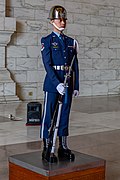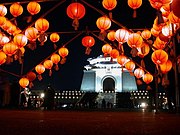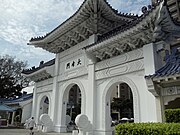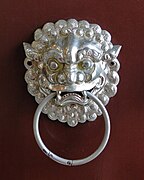-
Aerial view of the Memorial Hall
-
View of the front gate
-
Guard in the main chamber
-
The lower level exhibition area
-
Taipei Lantern Festival festivities on the square (2004)
-
Gardens in the grounds of the Memorial Hall
-
The Gate of Great Piety, a side gate
-
Door knocker on a lower level entrance
-
The Memorial Hall
-
Public toilet of the memorial park
-
Tank displayed next to Chiang Kai-shek Memorial for the Discovery Channel
-
The changing of the guard ceremony
中正紀念堂 | |
 | |
 | |
| 25°2′4″N 121°31′18″E / 25.03444°N 121.52167°E | |
| Location | Taipei, Taiwan |
|---|---|
| Designer | Yang Cho-cheng |
| Type | Memorial |
| Material | Concrete and marble |
| Height | 76 m (249 ft) |
| Beginning date | October 31, 1976 |
| Completion date | April 5, 1980 |
| Dedicated to | Chiang Kai-shek |
| Website | www www |
| Chiang Kai-Shek Memorial Hall | |||||||||||||||
|---|---|---|---|---|---|---|---|---|---|---|---|---|---|---|---|
| Traditional Chinese | 中正紀念堂 | ||||||||||||||
| Simplified Chinese | 中正纪念堂 | ||||||||||||||
| |||||||||||||||
The Chiang Kai-shek Memorial Hall (Chinese: 中正紀念堂; Pe̍h-ōe-jī: Tiong-chèng-kí-liām-tn̂g) is a national monument and tourist attraction erected in memory of Chiang Kai-shek, former President of the Republic of China. It is located in Taipei, Taiwan (ROC).
The monument, surrounded by a park, stands at the east end of Memorial Hall Square. It is flanked on the north and south by the National Theater and National Concert Hall.[1]
Description
[edit]The Memorial Hall is white with four sides. The roof is blue and octagonal, a shape that picks up the symbolism of the number eight, a number traditionally associated in China with abundance and good fortune. Two sets of white stairs, each with 89 steps to represent Chiang's age at the time of his death, lead to the main entrance. The ground level of the memorial houses a library and a museum documenting Chiang Kai-shek's life and career, with exhibits detailing Taiwan's history and development. The upper level contains the main hall, in which a large statue of Chiang Kai-shek is located, and where a guard mounting ceremony takes place at regular intervals.
Development
[edit]
After President Chiang Kai-shek died on 5 April 1975, the executive branch of the government established a Funeral Committee to build a memorial. The design, by architect Yang Cho-cheng, was chosen in a competition. Yang's design incorporated many elements of traditional Chinese architecture to mirror that of the Sun Yat-sen Mausoleum in Nanjing, China. (The Kuomintang (KMT) revered Dr. Sun as founder of the party and the government Chiang had led.) Groundbreaking for the memorial took place on 31 October 1976, the 90th anniversary of Chiang's birth. The hall officially opened on 5 April 1980, the fifth anniversary of the leader's death.
Yang's design placed the main building at the east end of the Chiang Kai-shek Memorial Park (中正紀念公園), covering over 240,000 square metres (290,000 sq yd) in Zhongzheng District. A main gate, the Gate of Great Centrality and Perfect Uprightness (大中至正) was placed at the west end on Chung Shan South Road, with a Gate of Great Loyalty (大忠門) standing at the north side on Hsin Yi (Xinyi) Road and a Gate of Great Piety (大孝門) standing at the south side on Ai Kuo (Aiguo) East Road. A Boulevard of Homage, bordered by manicured bushes, connected the main hall with the square.
Subsequent history
[edit]The square became Taipei's site of choice for mass gatherings as soon as it opened. The nature of many of those gatherings gave the site new public meanings. The hall and square became the hub of events in the 1980s and early 1990s that ushered Taiwan into its era of modern democracy. Of the many pro-democracy demonstrations that took place at the square, the most influential were the Wild Lily student movement rallies of 1990. The movement provided the impetus for the far-reaching political reforms of President Lee Teng-hui. These culminated in the first popular elections of national leaders in 1996.
The site's importance in the development of Taiwan's democracy led to the plaza's rededication as Liberty Square by President Chen Shui-bian in 2007.[2] Memorial Hall was also renamed in a dedication to democracy. The announcement of the new names were greeted with hostility by Kuomintang officials. The original dedication to Chiang was subsequently restored to the hall by President Ma Ying-jeou, while the name Liberty Square was eventually affirmed by officials across party lines.[3]
In 2017, on the occasion of the 70th anniversary of the February 28 Incident and the 30th anniversary of the lifting of martial law, Taiwan's Ministry of Culture announced plans to transform the hall into a national center for “facing history, recognizing agony, and respecting human rights.” Scholars and experts were invited to form an advisory group to help plan the hall's transformation.[1] Public discussion of the transformation began the following year in forums held throughout Taiwan.[4]
The Chinese inscription now over the main gate declares the plaza Liberty Square. The calligraphic style recalls that of Wang Xizhi in the East Jin Dynasty (see Chinese calligraphy). The style is noted for its sense of vitality, movement and freedom. The characters in the inscription are placed in left-to-right sequence to follow modern practice in Taiwan. (The right-to-left order of ancient Chinese tradition had been observed at the site up until then.)[5]
In 2018, pro-independence student activists stormed the hall and threw paint on the statue of Chiang Kai-Shek; two were arrested and penalized for NT$2,000.[6][7]
In 2019 the Chiang Kai-shek Memorial Hall hosted an exhibition by the Chinese artist Ling Feng (靈峰). The 88 works exhibited were sharply critical of the Chinese Communist Party and authoritarianism in general.[8]
In 2024, the Ministry of Culture announced the removal of military honor guards from the memorial as part of efforts to stop the promotion of a "cult of personality" around Chiang Kai-shek and "authoritarianism".[9]
Gallery
[edit]See also
[edit]- National Theater and Concert Hall
- Presidential Office Building
- Wild Lily student movement
- List of museums in Taiwan
References
[edit]- ^ a b "Transforming CKS Memorial Hall for transitional justice". Ministry of Culture Republic of China (Taiwan). February 24, 2017. Archived from the original on September 17, 2017. Retrieved September 16, 2017.
- ^ Ko Shu-ling, National Democracy Hall reopens, Taipei Times, 2 January 2008.
- ^ Flora Wang, Chiang Kai-shek plaque to return to memorial hall, Taipei Times, 22 January 2009.
- ^ "Memorial's fate undecided - Taipei Times". 7 September 2018.
- ^ New calligraphy styles decided for Memorial Hall name plaques, The China Post, 7 December 2007.
- ^ Charlier, Phillip (2018-07-20). "CKS Statue Splashed with Red Paint at CKS Memorial Hall". Taiwan English News. Retrieved 2021-11-06.
- ^ "Taiwan protesters pelt paint at famous Chiang Kai-shek statue". The Jakarta Post. 2018-07-20. Archived from the original on 2018-07-20. Retrieved 2021-11-06.
- ^ Jennifer Lin, Sophia Yang and (21 November 2019). "Swan Lake Meets Red Lady Army: Chinese artist's satirical art in Taipei reflects Hong Kong protest". www.taiwannews.com.tw. Taiwan News. Retrieved 21 November 2019.
- ^ "Taiwan to stop 'worshipping authoritarianism' at Chiang Kai-shek statue". Al Jazeera. Retrieved 2024-07-12.












